Influence Mechanism, Simulation, and Prediction of Urban Expansion in Shaanxi Province, China
Abstract
1. Introduction
2. Overview of the Study Area and Data Sources
2.1. Overview of the Study Area
2.2. Data Sources
2.3. Data Processing
3. Research Methodology
3.1. Expansion Intensity Index and Expansion Rate Index
3.2. CA–Markov Model
3.3. PLUS Model
3.4. Precision Testing
4. Findings
4.1. Spatial and Temporal Characteristics of Urban Land Expansion in Shaanxi Province
4.2. Factors Influencing Urban Land Expansion in Shaanxi Province
4.2.1. The Binding Force of Natural Geography
4.2.2. The Supporting Force of the Transportation Network
4.2.3. The Driving Force of Economic Development
4.2.4. Regulatory Power of Policy Guidance
4.2.5. Integration of History and Culture
4.3. Simulation and Prediction of Urban Land Expansion in Shaanxi Province
5. Discussion
5.1. Comparison with Existing Research
5.2. Research Limitations
5.3. Future Research Prospects
6. Conclusions
- (1)
- There are significant trends in land use. In the time span from 2000 to 2030, the growth trend of construction land was substantial, while the area of arable land showed a significant shrinking trend, with the main direction of transformation being toward construction land and unutilized land, demonstrating an obvious dynamic change trend.
- (2)
- On the basis of an in-depth analysis of the development history of central urban areas in Shaanxi Province over the past two decades, the influencing factors of urban land expansion in Shaanxi Province are categorized into five core dimensions: natural geographic conditions, the construction of transportation networks, the trend in economic development, the role of policy orientation, and historical and cultural background.
- (3)
- Multiple suitability factors, such as topography and road network density, were introduced to evaluate the suitability of land transfer. The results show that the multi-criteria evaluation method possesses a high degree of rationality and accuracy and is an effective tool for formulating the rules of land use transformation. Its Kappa index is as high as 0.70, which further confirms the accuracy of the method. Meanwhile, it also provides strong support for the applicability of the CA–Markov model in the simulation and prediction of the spatial evolution of urban land use.
Author Contributions
Funding
Data Availability Statement
Conflicts of Interest
References
- United Nations Human Settlements Programme. World Cities Report 2022: Envisaging the Future of Cities; United Nations Research Institute for Social Development: Geneva, Switzerland, 2022. [Google Scholar]
- OECD. Rethinking Urban Sprawl: Moving Towards Sustainable Cities; OECD Publishing: Paris, France, 2018. [Google Scholar]
- UN-Habitat. Global Urban Indicators Database: Lagos Metropolitan Analysis; United Nations Human Settlements Programme: Nairobi, Kenya, 2022. [Google Scholar]
- World Bank. Slum Upgrading in Mumbai: Spatial Equity and Service Delivery; World Bank Urban Development Series: Tokyo, Japan, 2021. [Google Scholar]
- Chen, L.; Gong, C.; Guo, Y.; Guo, Y.; Su, J.; Xu, X.; Xu, G. Integrating macro-micro perspectives to measure urban land expansion in Minsk, Belarus. J. Urban Manag. 2025; in press. [Google Scholar] [CrossRef]
- Mansour, S.; Alotaibi, O.; Alnasrallah, M. Geospatial modelling of urban expansion effects on the land ecosystems in Kuwait using random forest and cellular automata. J. Urban Manag. 2025; in press. [Google Scholar] [CrossRef]
- Ouyang, X.; Zhu, X. Spatio-temporal characteristics of urban land expansion in Chinese urban agglomerations. Acta Geogr. Sin. 2020, 75, 571–588. [Google Scholar]
- Yu, Y.; Hu, S.; Tong, Y. Research on modeling for urban expansion pattern recognition based on shared boundary analysis. Geogr. Geo-Inf. Sci. 2017, 33, 78–81. [Google Scholar]
- Zhang, X.; Liu, Y.; Wang, W. Simulation of multi-scenario land use change and its impact on ecosystem services in China based on PLUS-InVEST model. Acta Ecol. Sin. 2025, 19, 1–17. [Google Scholar]
- Huang, L.; Cheng, A.; Liu, X. Simulation and prediction of land use change and carbon storage spatiotemporal evolution in Yulin city based on the PLUS-InVEST model. Environ. Sci. 2025, 1–15. [Google Scholar]
- Reng, Y.; Liu, X.; Xu, X. Multi-scenario simulation of land use change and its impact on ecosystem services in Beijing-Tianjin-Hebei region based on the PLUS-InVEST model. Acta Geogr. Sin. 2023, 43, 4473–4487. [Google Scholar]
- Wang, K.; Qin, J.; Ma, H. Spatial-temporal evolution simulation and ecological response of urban expansion in western new city of Chongqing based on CA-Markov model. J. Univ. Chin. Acad. Sci. 2023, 40, 496–505. [Google Scholar]
- Cheng, C.; Hu, Y.; Feng, Y. Construction of urban ecological zones based on CA-Markov model: A case study of the main urban area of Jinzhong. Acta Ecol. Sin. 2020, 40, 1455–1462. [Google Scholar] [CrossRef]
- Bagheri, B.; Tousi, S.N. An explanation of urban sprawl phenomenon in Shiraz Metropolitan Area (SMA). Cities 2017, 73, 71–90. [Google Scholar] [CrossRef]
- Li, Y.; Meng, D.; Ye, H.P. Spatiotemporal pattern and driving forces of typical Russian cities: Based on remote sensing decision fusion and multiple discrete regression model. Geogr. Res. 2021, 40, 2967–2985. [Google Scholar]
- Li, G.D. Spatio-temporal change of global land cover and China’s contribution. Acta Geogr. Sin. 2022, 77, 353–368. [Google Scholar]
- Guan, D.; He, X.; He, C. Does the urban sprawl matter in Yangtze River Economic Belt, China? An integrated analysis with urban sprawl index and one scenario analysis model. Cities 2020, 99, 102611. [Google Scholar] [CrossRef]
- Chen, Y.; Xue, Y.; Hu, Y. How multiple factors control evapotranspiration in North America evergreen needleleaf forests. Sci. Total Environ. 2018, 622, 1217–1224. [Google Scholar] [CrossRef]
- Liao, J.; Shao, G.; Wang, C. Urban sprawl scenario simulations based on cellular automata and ordered weighted averaging ecological constraints. Ecol. Indic. 2019, 107, 105572. [Google Scholar] [CrossRef]
- Yuan, M.Y.; Li, J.X.; Zeng, L. Spatial-temporal Change and Driving Forces Analysis of Land-use in Xi’an City. Sci. Technol. Eng. 2022, 22, 13846–13855. [Google Scholar]
- Fan, X.; Qie, H. Analysis on the Characteristics of the Tempo-spatial Evolution of Xi’an Metropolitan Area. Urban Dev. Stud. 2021, 28, 34–39. [Google Scholar]
- Ge, Y.; Han, L.; Zhao, Y. Spatio-temporal analysis of urban expansion in Xi’an from 1984 to 2016. Shengtaixue Zazhi 2019, 38, 1491–1499. [Google Scholar]
- Xu, P.; Du, P. Remote Sensing Monitoring Analysis of City Expansion and Land Use Change in Xi’an. J. Beijing Union Univ. 2018, 32, 42–51. [Google Scholar]
- Xiao, H.; Xue, F.; Yang, Y. Relationships between construction land expansion and habitat quality change and coupling coordination in Xi’an. J. Arid Land Resour. Environ. 2023, 37, 56–64. [Google Scholar]
- Li, C.; Lou, N.; Yang, Y. Study on the relationship between spatio-temporal evolution of road network and urban spatial change in Xi’an. Sci. Surv. Mapp. 2021, 46, 173–180+200. [Google Scholar]
- Li, J.; Sun, S.; Zhao, D. Evaluation of spatial distribution of urban functions based on road network density—Taking Xi’an as an example. Res. Dev. 2023, 6, 97–105. [Google Scholar]
- Li, Y.; Chang, J.; Wang, Y. Land use simulation and prediction in the Yellow River Basin based on CA-Markov model. J. Northwest Agric. For. Univ. 2020, 48, 107–116. [Google Scholar]
- Gan, X.; Chen, J. Application of cellular automata model in urban expansion of Chengdu city. Remote Sens. Inf. 2022, 37, 116–122. [Google Scholar]
- Wang, B.; Liao, J.; Zhu, W. The weight of neighborhood setting of the PLUS model based on a historical scenario: A case study of land use simulation of urban agglomeration of the Golden Triangle of Southern Fujian in 2030. Acta Geogr. Sin. 2019, 39, 4284–4298. [Google Scholar]
- Ouyang, X.; He, Q.; Zhu, X. Simulation of impacts urban agglomeration land use change on ecosystem services value under multi-scenarios:Case study in Changesha-Zhuzhou-Xiangtan urban agglomeration. Econ. Geogr. 2020, 40, 93–102. [Google Scholar]
- Li, Y.; Lin, A.; Wu, H. Refined simulation of urban land use change with emphasis on spatial scale effect. Acta Geogr. Sin. 2022, 77, 2738–2756. [Google Scholar]
- Liu, X.; Li, X.; Wei, X. Study on Fusion Demarcation of Urban Development Boundary Based on MCR and CA Model: A Case Study of Xuzhou City. China Land Sci. 2020, 34, 8–17. [Google Scholar]
- Gao, X.; Song, Z.; Li, C. Landscape Pattern Optimization in Baiyangdian Basin Based on Landscape Ecological Risk Assessment. Shengtai Yu Nongcun Huanjing Xuebao 2023, 39, 174–183. [Google Scholar]
- Zhu, L.; Zhao, M.; Li, Y. The Space-time relationship between ecosystem service value and human activity intensity in Xi’an metropolitan area. Hengtai Yu Nongcun Huanjing Xuebao 2024, 40, 325–334. [Google Scholar]
- Li, T. Research on the Spatial Development of the New Zone Located in the Edge of Xi’an City Since the 1990s—Xi’an Economic-Technological Development Area. Master’s Thesis, Xi’an University of Architecture and Technology, Xi’an, China, 2015. [Google Scholar]
- Gao, X.; Yang, L.; Wanqing, L. Land use change and ecosystem service value measurement in Baiyangdian Basin under simulated multiple scenarios. Shengtai Xuebao 2021, 41, 7974–7988. [Google Scholar]
- Song, B.; Zhou, Z. Influence of road network on landscape pattern in Xi’an metropolitan zone. Jilin Daxue Xuebao, Diqiu Kexueban 2017, 47, 1521–1532. [Google Scholar]
- Li, C.; Wu, K.; Gao, X. Manufacturing industry agglomeration and spatial clustering: Evidence from Hebei Province, China. Environ. Dev. Sustain. 2020, 22, 2941–2965. [Google Scholar] [CrossRef]
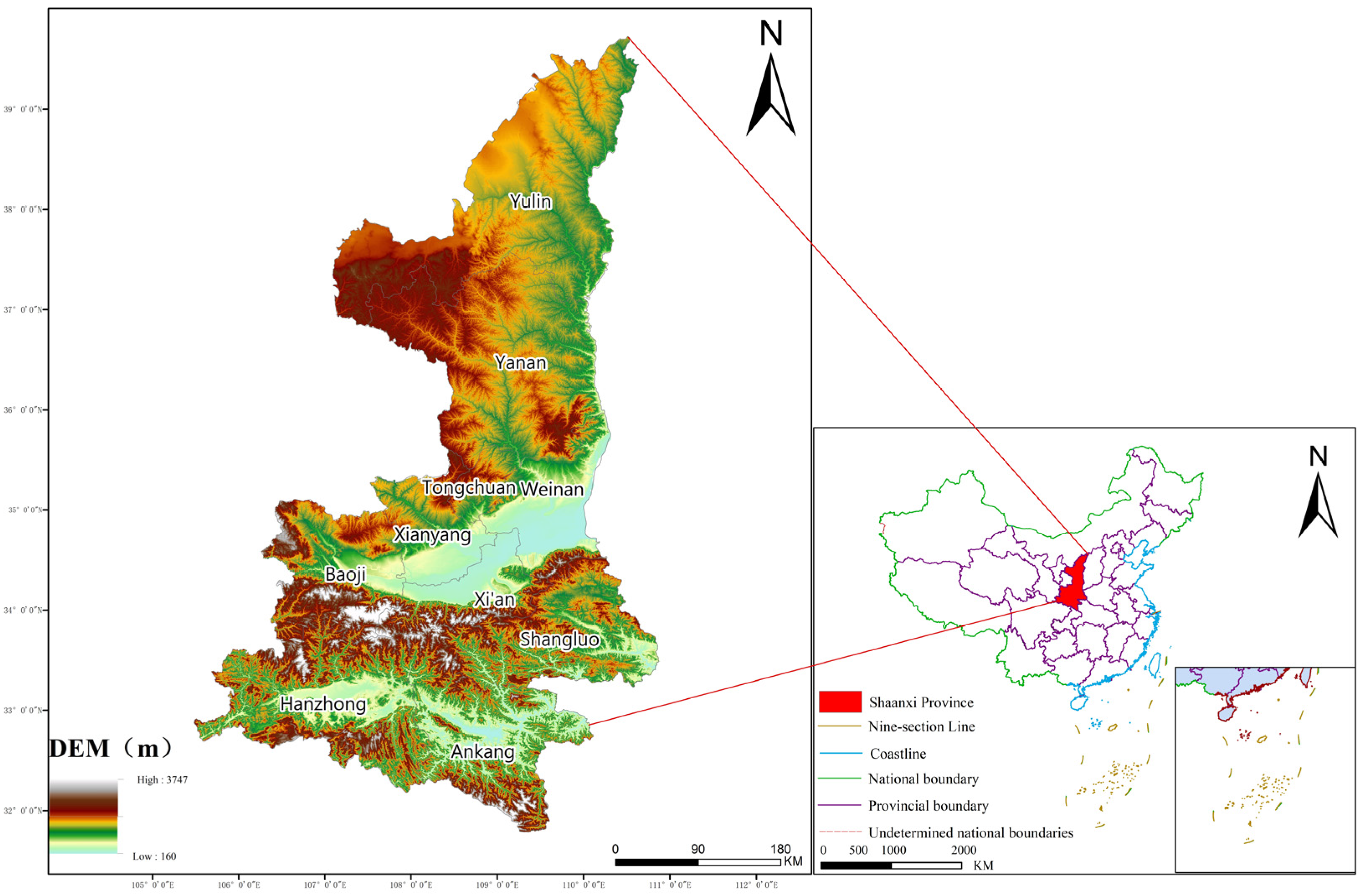
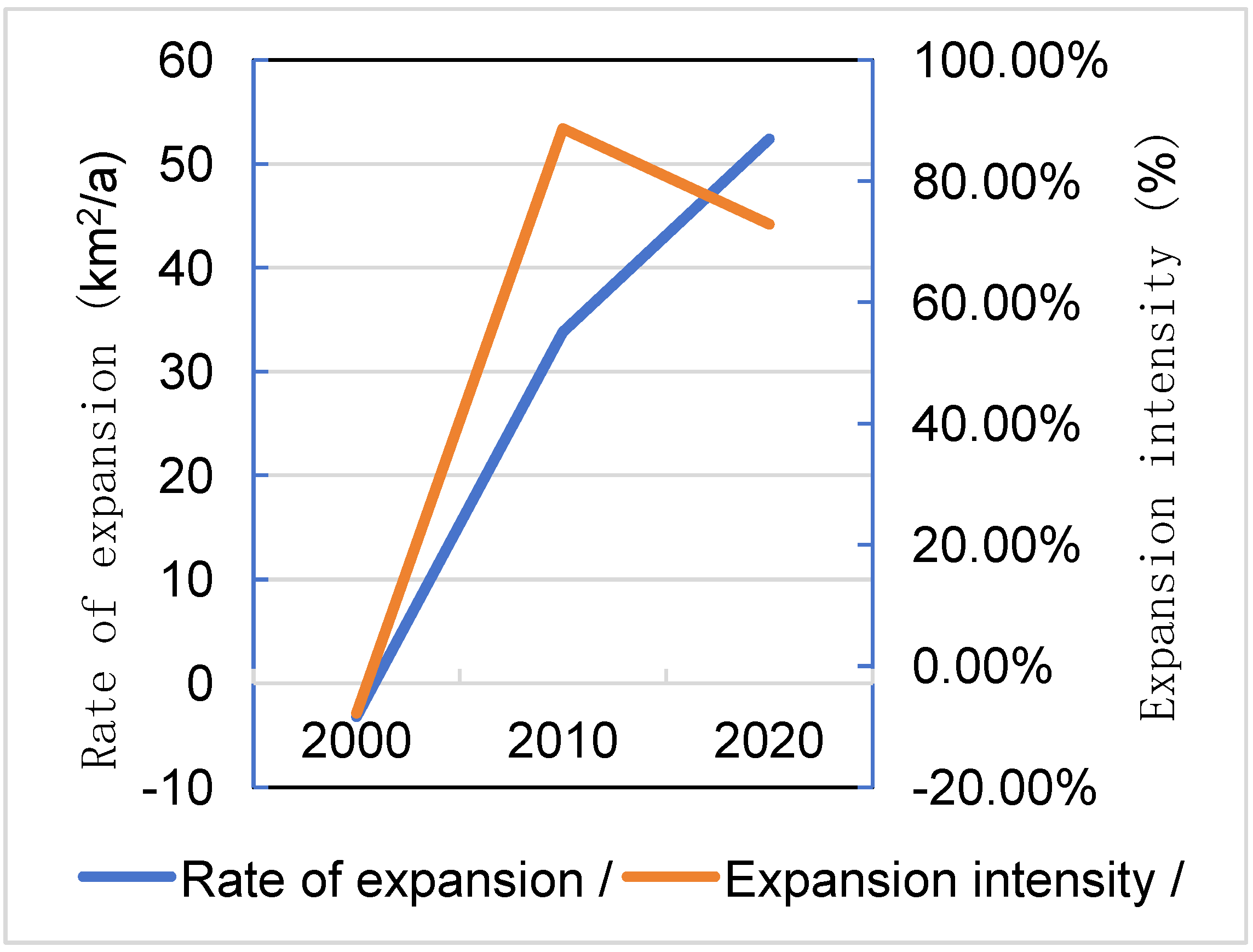

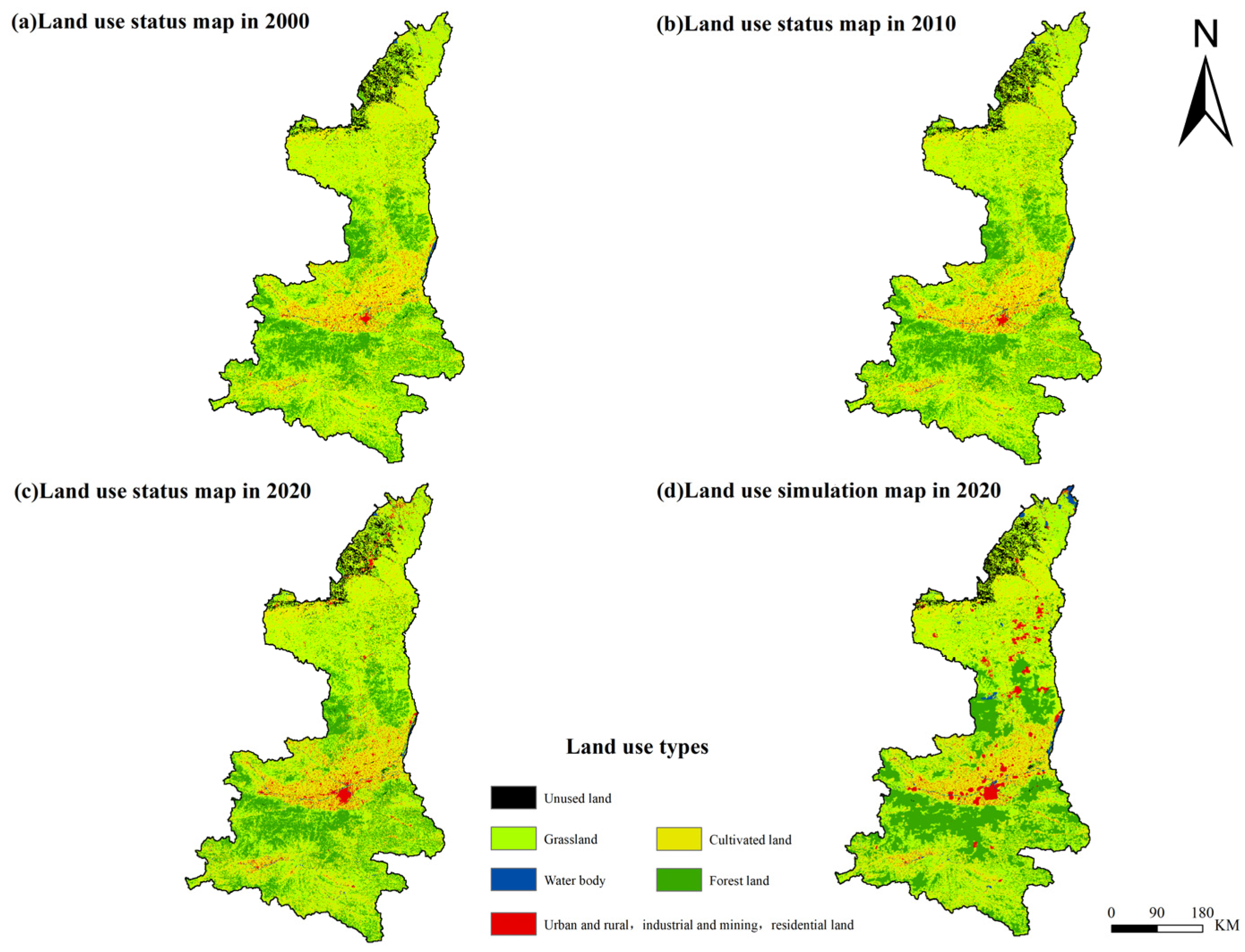
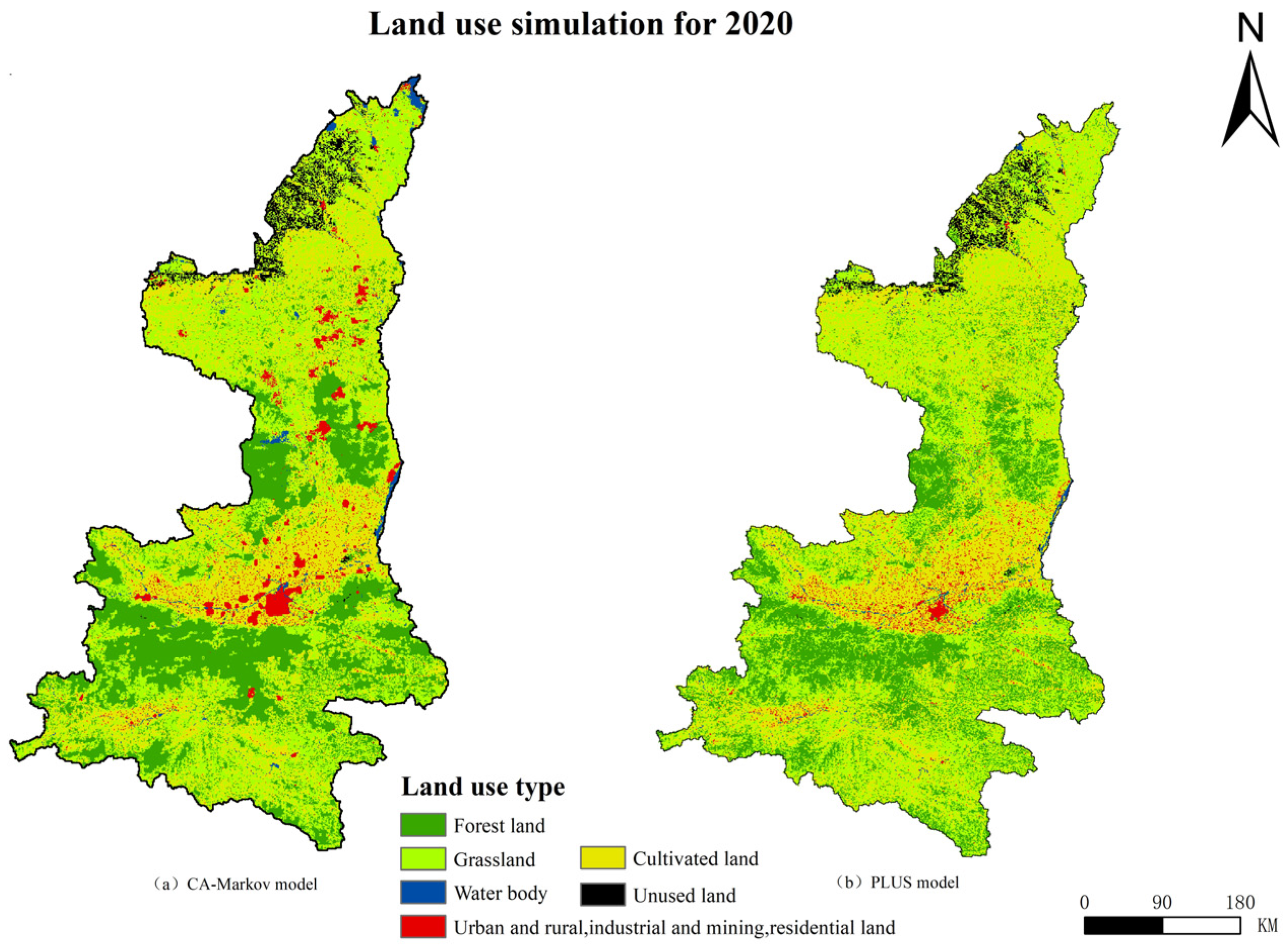
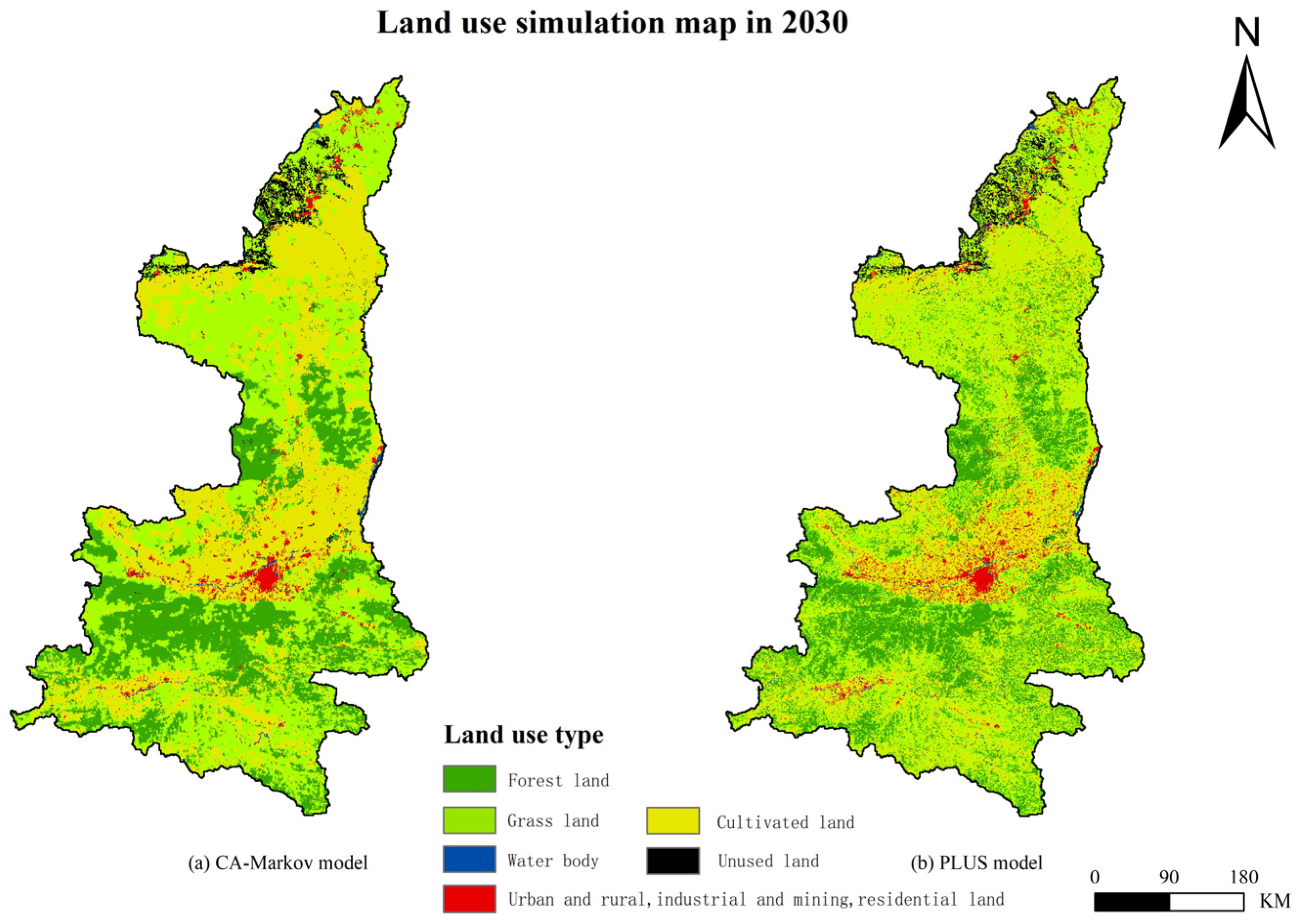
| Data Type | Data Name | Resolution | Data sources |
|---|---|---|---|
| Land Use Data | Land use data in 2000, 2010, and 2020. | 1 km | Resources and Environmental Science and Data Center, Chinese Academy of Sciences (https://www.resdc.cn, accessed on 1 July 2024) |
| Natural Environment Data | Elevation | 1 km | Geospatial Data Cloud (https://www.gscloud.cn/, accessed on 19 July 2025) |
| Slope | 1 km | ||
| Socioeconomic Data | Population Density | 1 km | Global Change Research Data Publishing & Repository (http://www.geodoi.ac.cn/, accessed on 18 July 2025) |
| GDP | 1 km | ||
| Proximity to Highway | 1 km | OpenStreetMap (https://www.openstreetmap.org/, accessed on 20 May 2025) | |
| Proximity to Primary Road | 1 km | ||
| Proximity to Secondary Road | 1 km | ||
| Proximity to Tertiary Road | 1 km |
| 2010 | ||||||||
|---|---|---|---|---|---|---|---|---|
| 2000 | Cultivated Land | Forest Land | Grass Land | Water Body | Urban and Rural, Industrial and Mining, Residential Land | Unused Land | Grand Total | Transfer-out Amount |
| Cultivated land | 69,873 | 766 | 744 | 132 | 348 | 4 | 71,867 | 1994 |
| Forest land | 12 | 46,431 | 47 | 5 | 24 | 10 | 46,529 | 98 |
| Grass land | 121 | 579 | 76,756 | 24 | 34 | 40 | 77,554 | 798 |
| Water body | 98 | 7 | 13 | 1742 | 5 | 2 | 1867 | 125 |
| Urban and rural, industrial and mining, residential land | 1 | 0 | 3 | 0 | 3059 | 0 | 3063 | 4 |
| Unused land | 31 | 8 | 131 | 4 | 6 | 4666 | 4846 | 180 |
| Grand total | 70,136 | 47,791 | 77,694 | 1907 | 3476 | 4722 | 205,726 | 3199 |
| Transfer volume | 263 | 1360 | 938 | 165 | 417 | 56 | 3199 | |
| Type | Cultivated Land | Forest Land | Grass Land | Water Body | Urban and Rural, Industrial and Mining, Residential Land | Unused Land |
|---|---|---|---|---|---|---|
| Domain weight | 1 | 0.746 | 0.085 | 0.023 | 0.243 | 0.07 |
| Type | Cultivated Land | Forest Land | Grass Land | Water Body | Urban and Rural, Industrial and Mining, Residential Land | Unused Land |
|---|---|---|---|---|---|---|
| Cultivated land | 1 | 1 | 1 | 1 | 1 | 1 |
| Forest land | 1 | 1 | 1 | 0 | 1 | 1 |
| Grass land | 1 | 1 | 1 | 1 | 1 | 1 |
| Water body | 1 | 0 | 1 | 1 | 0 | 1 |
| Urban and rural, industrial and mining, residential land | 1 | 1 | 1 | 0 | 1 | 1 |
| Unused land | 1 | 1 | 1 | 1 | 1 | 1 |
| Parameters | 1990 | 2000 | 2010 | 2020 |
|---|---|---|---|---|
| Urban area (km2) | 413 | 381 | 719 | 1243 |
| Expansion area (km2) | / | −32 | 338 | 524 |
| Expansion intensity (%) | / | −7.75% | 88.71% | 72.88% |
| Rate of expansion (km2/a) | / | −3.2 | 33.8 | 52.4 |
| Year | Cultivated Land | Forest Land | Grass Land | Water Body | Urban and Rural, Industrial and Mining, Residential Land | Unused Land | |
|---|---|---|---|---|---|---|---|
| Actual land area(km2) | 2000 | 71,863 | 46,596 | 77,593 | 1871 | 3072 | 4817 |
| 2010 | 70,147 | 47,847 | 77,736 | 1909 | 3480 | 4693 | |
| 2020 | 67,015 | 48,031 | 79,071 | 1724 | 5586 | 4388 | |
| The CA–Markov model simulates the area of land type (km2) | 2020 | 61,318 | 54,221 | 74,434 | 3077 | 7426 | 5252 |
| The PLUS model simulates the area of land type (km2) | 2020 | 68,480 | 49,078 | 77,858 | 1909 | 3839 | 4648 |
| The CA–Markov model simulates the area of land type.(km2) | 2030 | 70,375 | 46,690 | 78,063 | 1666 | 4575 | 4408 |
| The PLUS model simulates the area of land type.(km2) | 2030 | 65,092 | 49,169 | 79,062 | 1689 | 6558 | 4182 |
Disclaimer/Publisher’s Note: The statements, opinions and data contained in all publications are solely those of the individual author(s) and contributor(s) and not of MDPI and/or the editor(s). MDPI and/or the editor(s) disclaim responsibility for any injury to people or property resulting from any ideas, methods, instructions or products referred to in the content. |
© 2025 by the authors. Licensee MDPI, Basel, Switzerland. This article is an open access article distributed under the terms and conditions of the Creative Commons Attribution (CC BY) license (https://creativecommons.org/licenses/by/4.0/).
Share and Cite
Li, C.; Chen, H.; Fang, Y. Influence Mechanism, Simulation, and Prediction of Urban Expansion in Shaanxi Province, China. Land 2025, 14, 1637. https://doi.org/10.3390/land14081637
Li C, Chen H, Fang Y. Influence Mechanism, Simulation, and Prediction of Urban Expansion in Shaanxi Province, China. Land. 2025; 14(8):1637. https://doi.org/10.3390/land14081637
Chicago/Turabian StyleLi, Chenxi, Huimin Chen, and Yingying Fang. 2025. "Influence Mechanism, Simulation, and Prediction of Urban Expansion in Shaanxi Province, China" Land 14, no. 8: 1637. https://doi.org/10.3390/land14081637
APA StyleLi, C., Chen, H., & Fang, Y. (2025). Influence Mechanism, Simulation, and Prediction of Urban Expansion in Shaanxi Province, China. Land, 14(8), 1637. https://doi.org/10.3390/land14081637







